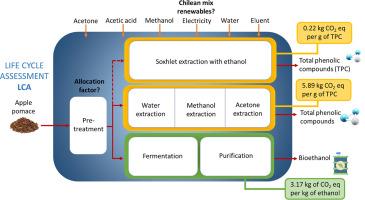Environmental insights of bioethanol production and phenolic compounds extraction from apple pomace-based biorefinery
引用次数: 0
Abstract
Food waste is one of the main challenges of solid waste management throughout the food supply chain. Apples are one of the most widely consumed fruits worldwide, the production of which is accompanied by the generation of pomace as a by-product with valuable nutrients. This research presents the first environmental insights of a multiproduct apple pomace-based biorefinery through a life cycle perspective. The design and process modelling of this platform aims to produce bioethanol and extract total phenolic compounds (TPC) towards an efficient use of the pomace obtained from the apple manufacturing industry (juice production). Bioethanol production consist of pressing, fermentation, distillation as the main processes; while in the case of TPC, two extraction techniques were evaluated: i) solvent extraction (mainly water), and ii) the Soxhlet method. The life cycle analysis followed an attributional cradle-to-gate approach considering different midpoint impact categories from the ReCipe 2016 method such as Global Warming (GW), Eutrophication, Human Toxicity, Fossil Scarcity, among others. The results indicate that bioethanol production encompasses a GW profile of 3.17 kg of CO2 eq per kg of product, being the vinasse treatment (subproduct after distillation) the most impactful stage. Phenolic compounds extraction with water achieves a total value of 5.8 kg CO2 eq per g of TPC, while 0.22 kg CO2 eq per g of TPC is obtained with Soxhlet technique. Furthermore, a sensitivity analysis is addressed to improve the environmental profile of bioethanol and TPC. This research demonstrated the relevance of process design on the environmental performance of bioethanol and TPC, where stillage treatment has a key contribution to the results and the use of solvents in TPC extraction, although improving extraction yield, leads to a higher environmental impact.

生物乙醇生产和从苹果渣中提取酚类化合物的环境见解
食品垃圾是整个食品供应链中固体废物管理的主要挑战之一。苹果是世界上消费最广泛的水果之一,它的生产伴随着果渣的产生,作为一种副产品,具有宝贵的营养成分。这项研究通过生命周期的角度提出了多产品苹果渣生物炼制的第一个环境见解。该平台的设计和工艺建模旨在生产生物乙醇和提取总酚化合物(TPC),以有效利用从苹果制造业(果汁生产)获得的果渣。生物乙醇生产以压榨、发酵、蒸馏为主要工艺;而在TPC的情况下,评估了两种提取技术:i)溶剂提取(主要是水)和ii)索氏法。生命周期分析采用了从摇篮到门的归因方法,考虑了来自ReCipe 2016方法的不同中点影响类别,如全球变暖(GW)、富营养化、人类毒性、化石稀缺等。结果表明,生物乙醇生产包含每千克产品3.17千克二氧化碳当量的GW剖面,是酒糟处理(蒸馏后的子产品)最具影响力的阶段。水提酚类化合物得到的总CO2当量为5.8 kg / g TPC,索氏法得到的总CO2当量为0.22 kg / g TPC。此外,还进行了敏感性分析,以改善生物乙醇和TPC的环境状况。该研究证明了工艺设计与生物乙醇和TPC环境性能的相关性,其中,蒸馏处理对结果有关键贡献,而在TPC提取中使用溶剂,尽管提高了提取率,但会导致更高的环境影响。
本文章由计算机程序翻译,如有差异,请以英文原文为准。
求助全文
约1分钟内获得全文
求助全文

 求助内容:
求助内容: 应助结果提醒方式:
应助结果提醒方式:


